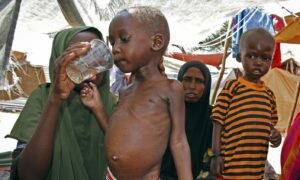![]() “Everybody’s reading about the disaster taking place in Minnesota.” With these words Donald Trump branded the Somali community in Minnesota just before he won the U.S. presidential election. Trump’s disparaging characterization evokes an interesting question: Why have European officials looked to the Twin Cities of Minnesota for the last decade to understand how Somali refugees have achieved economic incorporation if their presence has brought about a disaster? More important, how can we reconcile the “disaster” Trump mentions with important levels of Somali economic achievement, especially compared to what we see in many European countries such as Sweden?
“Everybody’s reading about the disaster taking place in Minnesota.” With these words Donald Trump branded the Somali community in Minnesota just before he won the U.S. presidential election. Trump’s disparaging characterization evokes an interesting question: Why have European officials looked to the Twin Cities of Minnesota for the last decade to understand how Somali refugees have achieved economic incorporation if their presence has brought about a disaster? More important, how can we reconcile the “disaster” Trump mentions with important levels of Somali economic achievement, especially compared to what we see in many European countries such as Sweden?

Benny Carlson
Examining the Somalia diaspora in Minnesota and Sweden is a somewhat natural comparison. To a large extent, Minnesota is dominated by ancestors of Swedish immigrants. As scholars from the United States (Chambers) and Sweden (Carlson) who have individually studied and published on the economic position of the transatlantic Somali diaspora, we are keenly interested in the mischaracterization of Somalis in Minnesota by President Trump. Our objective in this article is to highlight some of our findings, especially as they relate to Somali economic incorporation in Minnesota. By identifying the positive accomplishments in Minnesota we hope European leaders, like those in Sweden, may learn from what is actually happening in Minnesota.

Stefanie Chambers
To draw comparisons between the Somali experience in Minnesota and Sweden, it is first necessary to present some preliminary population data. Approximately one-third of all Somali-Americans reside in Minnesota, a state with a population of around 5.4 million. The 2015 American Community Survey estimates that 74,000 Somalis reside in the state. This estimate includes all Somalis, whether born in Somalia or the United States. Somalis themselves claim much higher numbers, largely due to untracked secondary migration to Minnesota. Turning to Sweden, in 2015 there were 60,000 Somalia-born residents in a country of approximately 10 million.
Community comparisons: Minnesota and Sweden
Working-age Somalia-born, those between 16 and 64, are estimated to number around 21,000 in Minnesota. In Sweden, the corresponding figure is 44,000. Employment and self-employment figures for working age Somalis in Minnesota are somewhat unreliable since they are based upon a survey known to undercount Somalis. However, if we calculate five-year (2011-2015) employment averages, 62 percent of Somali-Americans are employed and self-employment stands at 5.9 percent. Equivalent figures at the national level are 58 and 5.1 percent respectively. The somewhat higher figures in Minnesota are explained by the overall strong economy of that state. In Sweden, employment rates from 2011-2015 among Somalia-born of the same age stands at 26 percent with self-employment at 0.7 percent. That is, employment among Somalis in Minnesota is more than twice as high and the level of self-employment about eight times higher than in Sweden. No wonder Swedish officials have been glancing toward “Snoose Boulevard,” the Cedar-Riverside area in Minneapolis where Swedish immigrants once lived and where Somali immigrants are now heavily concentrated.
Comparisons between Minnesota (or the United States more broadly) and some other European countries will of course show somewhat varying results. There are important political and economic differences between these nations and a range of different refugee policies. However, employment figures among Somalia-born give no reason to rejoice anywhere in Europe. Scholarly reports from Norway, Denmark and the Netherlands display Somali employment around 30 percent and self-employment less than 1 percent. Employment in the United Kingdom is no better, but self-employment is more lively there, which has attracted a secondary movement of tens of thousands of Somalis from other parts of Europe, particularly the Netherlands and Sweden.
The role of entrepreneurship
What intrigues us is the important role of entrepreneurship/self-employment among Somalis in Minnesota since the difference compared to Sweden is so amazingly large. There are a host of explanations for these differences. In Minnesota, compared to Sweden, positive and negative incentives, “carrots and sticks,” are strong, and entrepreneurial entry barriers are lower. On the positive side, there are plenty of low-skill jobs that require limited English proficiency; new immigrants can earn and save money; the ethnic market is concentrated; there are Islamic-compliant funding options, an abundance of available storefronts (not least within Somali shopping malls), and a rich web of nonprofit and for-profit organizations ready to support the Somali community. On the “stick” side, it is not possible to live on social welfare for very long in the United States — even in Minnesota, where benefits are somewhat more generous than in other areas of the country. Therefore, economic and entrepreneurial opportunities are encouraged due to the rules of starting a business and the short timeframe for governmental support.
There are, of course, also some other basic differences between Somalis in Minnesota and Sweden. Time in the host country and educational level are perhaps the two most important and measurable variables behind economic incorporation. Somalis have on average spent more time in Minnesota compared to Sweden and they are generally better educated, though much of this education has been acquired within the United States. Some Somalis also attained English language skills during their time in refugee camps. In stark contrast, no one speaks Swedish before entering Sweden, a hurdle that poses a great challenge to Somali economic incorporation.
Optimistic in Minnesota
Back in 2005, one of us (Carlson) visited the Twin Cities and interviewed several Somalis, six of whom were entrepreneurs. They shared similar stories about moving around the world and within the United States before settling in Minnesota. Whereas they were disappointed with the economic opportunities at many earlier stops, they were now optimistic about their future in Minnesota.
During that 2005 visit one male entrepreneur with experiences in the Netherlands, Belgium and Canada explained, “European societies are closed and you have to explain every step you want to take; Europeans are pursuing a policy for losers.” He continued by stating, “In America you can take a leap without having to explain every step. As long as you work hard and pay tax, nobody cares if you are a Somali or not.”
“Life in America is tough but good,” said a female shop-owner who had traveled from Kenya to Minneapolis. “If you have a dream you can fulfill it.”
“You can be what you want – the lowest of the lowest or the highest of the highest,” testified a successful restaurant owner, adding: “Nobody wants to crush your dream. There’s opportunity here.”
The barriers preventing Somalis from economic incorporation in Sweden can perhaps be best identified through Somalis who left Sweden for the U.K. In 2011 we (Carlson) interviewed 16 Somali Swedish entrepreneurs in Birmingham and Leicester. A selection of quotes captures their collective frustration with Sweden: “Difficult to understand how society works.” “Everything is so bureaucratic.” “You have to open one door, only to find there’s another door, and so on.” “Too many offices.” “It scares you off when you discover what’s needed to start up your own business and pay tax.” “You’re always a foreigner.” “If you start up a business in Sweden you set up a paper factory.” There were of course also many statements about the good sides of Sweden: decent housing, good schools and quality health care.
American dream very much alive
According to recurring reports the American dream is dying among middle- and working-class Americans. These claims were largely substantiated during the 2016 presidential election, when the plight of the working class took center stage. However, during visits to Minnesota as late as 2015 (Chambers and Carlson), the dream was very much alive among Somali entrepreneurs in Minnesota. Somalis in Minnesota thus showed the same unbending optimism in 2015 as they had in 2005. However, clouds have amassed over the Minnesota sky. Reports of young Somalis from Minnesota leaving for the Middle East and East Africa to join ISIS and al-Shabaab captured the headlines. Similarly, when a mentally ill Somali-American stabbed eight people in a shopping mall in St. Cloud, before being shot by a police officer, the media publicized the story widely.
When putting these realities in perspective – on the one hand thousands of optimistic entrepreneurs who are pledging allegiance to America, on the other hand a small number of radicalized, destructive and admittedly dangerous youngsters – there is no doubt in which direction the scales should tip. However, in the era of the Trump presidency, the scales have tipped to emphasize the terrorist threat.
What is in the future for Somali-American entrepreneurs in Minnesota, with a president who is outspoken anti-Muslim and characterizes the Somali community as a “disaster”? A president who has issued two travel bans that will stop the migration of Somali refugees and other vulnerable Muslim asylum seekers from around the world?
For years Somali entrepreneurs have reiterated this saying: “Nobody wants to crush your dream.” Well, things have changed. Now there is someone who wants to crush their dreams. Will economic rationality trump Trump’s prejudice or will Trump’s prejudice trump economic rationality? Will perhaps “a great wall,” at least of a mental kind, be erected around this community? We urge the president and other leaders to learn from the entrepreneurial experience, success, and drive among Somali-Americans. If we focus on these important achievements and the policies that have helped shaped their successes, perhaps we can create models that can be preserved in Minnesota and adapted in European countries such as Sweden.
Benny Carlson is a professor in the Department of Economic History at Lund University, Sweden. Stefanie Chambers is the Charles A. Dana Research Associate Professor of Political Science at Trinity College, Hartford, Connecticut. She is the author of “Somalis in the Twin Cities and Columbus: Immigrant Incorporation in New Destinations.”




















